Nike Zoom Vaporfly 4%
The Vaporfly 4% is the lighter brother of the Zoom Fly reviewed a couple of weeks ago. Is this shoe better than the Zoom Fly?
The answer is simple: No! Not close! And not even as good. There are a lot of features I like about the Zoom Fly; few of those are evident in the Zoom Vaporfly 4%; I’m not just talking about the Zoom Fly’s more attractive price.
Let’s start with the good. The Zoom Vaporfly 4% is light, and at 6.5 oz. for a men’s size 10 is very light. Compare this to the 8.75 oz. for the same size Zoom Fly and it’s a big difference. Unfortunately that is about all that is good about this shoe, at least for me.
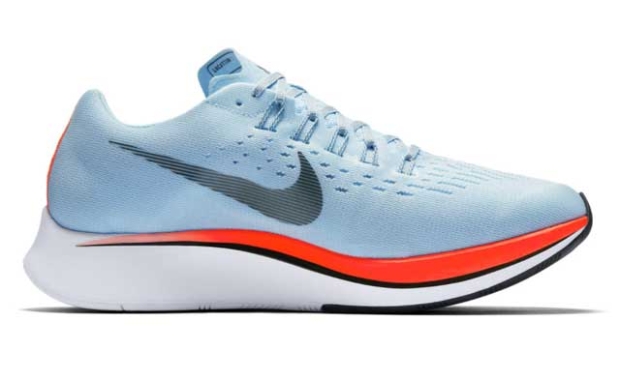
The difference in weight is due in large part to the different midsole material. The regular Zoom Fly is made of Lunarlon, a foam used in several other Nike shoes as well. The Zoom Vaporfly 4% is made of what Nike calls the ZoomX material, which is used in the Vaporfly Elites (the shoes used by the most important Nike sponsored athletes). The Zoom Vaporfly 4% is sits in between the Zoom Fly (the $150 shoe very favorably reviewed here a couple of weeks ago) and the unobtainable Zoom Vaporfly Elite which only Nike’s top sponsored athletes have access to.
This ZoomX foam is really different then the Lunarlon foam that is used on the Zoom Fly. It feels different when you touch it, it sounds different and it is much, much softer. Also, in the Zoom Vaporfly 4% the midsole is built with much less material under the arch, and is carved out. This makes the shoe also less stable and runs counter to what you see nowadays in the shoes from Hoka and Saucony, currently the favorite brands of triathletes.
Should the full carbon plate, that is such an important feature of the Zoom Fly, be lighter and stiffer in this shoe? I think so, since the Vaporfly 4% is a $250 shoe compared to the Zoom Fly’s $150 price. So far I really can’t tell the difference in the stiffness of the plate between the two shoe. Maybe it is lighter, I don’t know, but stiffer? I doubt it.
Does the plate need to be stiffer? I don’t know, but as noted above the shoe is much softer, and in every run I take in them I start out feeling wobbly for the first 4 to 5 minutes. As in, my foot needs to search for purchase in these shoes for the first kilometer or more. I found the Zoom Fly already a bit wobbly but got used to that quite quickly; it is a stable shoe compared to the Zoom Vaporfly 4%. Sharp turns at higher speeds are a nightmare in this shoe. This might be me, but I don’t like the feeling of drifting on the midsole.
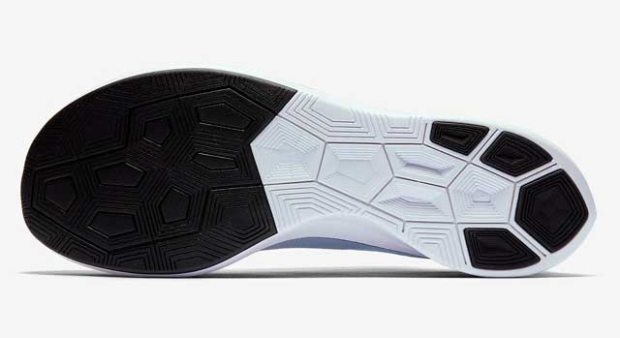
The outsole is quite similar to the regular Zoom Fly. No big difference there.
The upper is also a lot different compared to the cheaper model. It’s thinner, very noticeable at the heel and the heel collar. There is almost no padding, the lacing is also different as well as the tongue. The tongue is not different in shape, but it is in material. For me it feels much firmer, a little, well, plastic. And through this I feel much more pressure form the laces on my tendons on top of my feet.
On the inside the sock liner or insole is glued tight in the shoes. If you wear orthotics, too bad for you. But then no decent orthotic could retain its utility in a shoe so devoid of support. There is an edge in the arch area that presses on both my arches.
As if the above weren’t enough my biggest issue is the fit of the shoe. It is so wide, so roomy it’s hard to imagine it shares a genus of Nike shoes with the Zoom Fly. This partly due to the actual difference in fit, partly that there are no half sizes. Yes, you read this right.
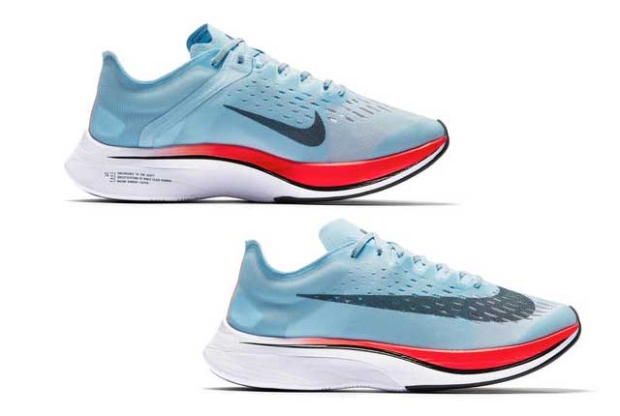
You pay $250 for the shoe and you can only choose from full sizes. At least that is the case when I ordered them from Nike.com. [Editor's note: See Facebook comments below that run contrary to Jeroen's European experience.] A running shoe, specifically at this price point and meant for racing, should have the most optimized fit. I really have a hard time getting this. At the ordering process I had to choose from either a size 7 or a size 8, and also the rest were just sizes 9, 10, 11 and so on. In the Zoom Fly I’m in a size 7.5 and those fit great but a half size smaller and I can just say goodbye to my toenails. So I took the size 8.
The length is really not the problem; the shoe is just slightly longer than my Zoom Fly. But the width or volume in the shoe, specifically in the forefoot area, is far from regular and I have wide feet. I can lay another standard insole (sock liner) on top of the glued insole and that gives me the same feeling in the forefoot as I have in the Zoom Fly. It does take care of the annoying edge that I feel from the standard insole, but it positions me higher in the heel and it adds an even more to the already unstable feeling. This really doesn’t work.
But are they fast? Yes, they are. As with the Zoom Fly, there is a certain amount of bounce and energy return from these shoes. More than from the Zoom Fly? After several 1000-meter interval sessions I am routinely a few seconds faster per kilometer in the Zoom Vaporfly 4%. Each and every session and on every 1000m run I used the 4% I am faster. Is the shoe 4% faster, memorialized in the name? This I couldn’t tell you.
But for a longer run or race there are way too many other bothersome issues for me to really like them. The elements that annoy me will catch up and overtake the features (such as the lighter weight) and make me slower.
I have around 150 miles in them and I think there is another 150 miles or so, but that seems about as much as there is. I already can feel the difference in the midsole between the brand new shoe and the shoe at 150 miles in.
The Zoom Vaporfly 4% retails for $250 and is a unisex model.
[Editor's note: Our capable editor-at-large for footwear Jeroen van Geelen owns TriPro, one of the more important triathlon bike fit and retail establishments in The Netherlands.]


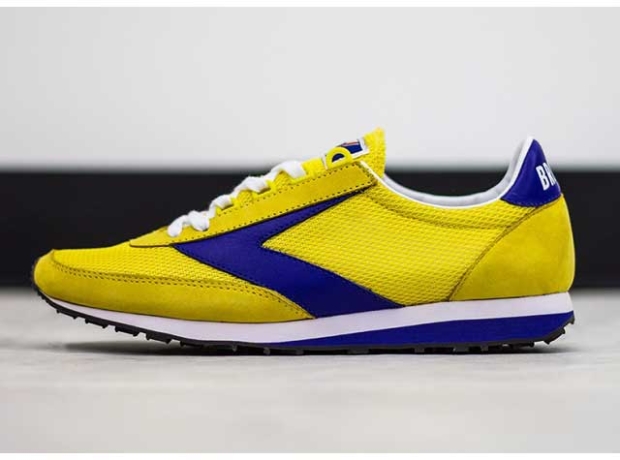
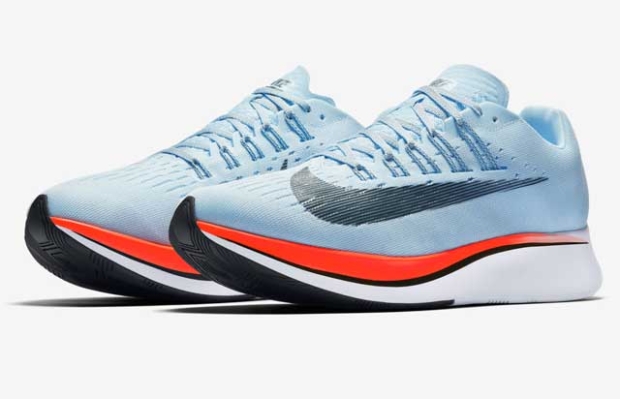
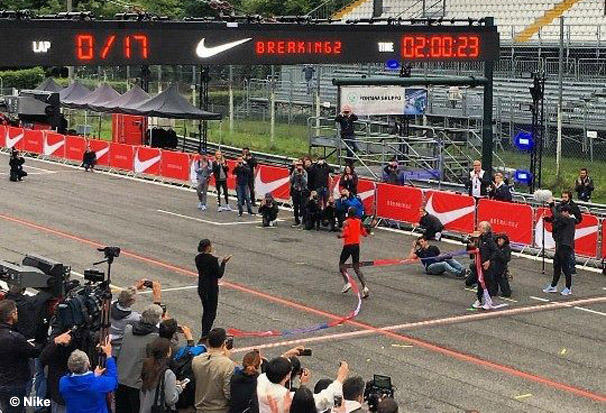
Start the discussion at forum.slowtwitch.com